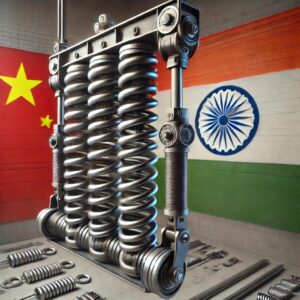Navigating International Manufacturing Agreements: The Power of Term Sheets
Outsourcing manufacturing requires meticulous planning, skillful negotiation, and unwavering attention to detail. International Manufacturing Terms sheets can streamline this process, by helping manufacturers and product buyers establish crucial terms before embarking on the formal drafting of a comprehensive Manufacturing Agreement.
The Role of Term Sheets
Consider this scenario: a United States-based company contemplates manufacturing a groundbreaking line of electronic products in Vietnam to harness cost advantages. The potential gains are substantial — from reduced labor costs and access to skilled engineers to the strategic diversification of the supply chain to counteract geopolitical uncertainties. However, diving headlong into a complex international agreement that would come with this can foster confusion, disputes, and needless financial outlays.
Enter International Manufacturing Term Sheets, sometimes referred to as memorandums of understanding (MOUs) or Letters of Intent (LOIs). These term sheets function as a prologue to a comprehensive Manufacturing Agreement — a sort of roadmap that outlines the core terms that will underpin the manufacturing relationship between the manufacturer and the product buyer.
By instituting a transparent, concise, and mutually agreed-upon understanding of various fundamental manufacturing components from the outset, term sheets pave the way for a smoother process when the time comes to formalize the final agreement. This harmonization regarding crucial issues reduces the chances of misunderstandings and economizes both time and legal expenses that would otherwise be invested in ironing out conflicts later on.
Hammering out a Manufacturing Term Sheet with your potential manufacturer can not only refine your understanding of each other’s positions and dynamics, it can also serve as a litmus test to determine the feasibility of proceeding further. If negotiating the term sheet reveals fundamental disagreements or misalignments, it becomes an opportunity for you to avoid committing significant additional time and financial resources to drafting a comprehensive International Manufacturing Agreement.
The Benefits of Term Sheets
The strategic use of term sheets confers a host of benefits on both product buyer and manufacturer involved in international outsourcing agreements, including the following
Time and Cost Savings. Negotiating major terms upfront streamlines the contract drafting process, reduces the back-and-forth over missed issues, and minimizes legal drafting and review time.
Alignment and Clarity. Term sheets provide a clear roadmap, ensuring both the buyer and manufacturer are on the same page regarding critical issues before commencing the full agreement, thereby reducing the likelihood of confusion, disagreements, and misaligned expectations.
Faster Negotiations: Negotiating a term sheet establishes mutual understanding on key terms and creates anchor points that accelerate remaining negotiations.
Risk Mitigation. Vetting core issues upfront enables both parties to assess and address potential risks, challenges, and capacity constraints, before contract drafting.
Customization. Your International Manufacturing Term Sheet can and should be customized to suit the specific needs of the buyer-manufacturer relationship, and to thereby ensure that the Manufacturing Agreement will also match the strategic priorities of each party.
Globally Consistent Framework. International Manufacturing Term Sheets can help you establish a consistent framework aligned to your company’s standards and facilitate consistency and operational efficiency across your global supply chain.
When to Start the Term Sheet Process
You should ideally begin discussions revolving around key manufacturing terms during the later stages of relationship-building, after mutual interest in collaboration has been established, and due diligence conducted, but before you embark on the actual drafting of the Manufacturing Agreement. Diving into the minutiae of a full agreement before ensuring alignment on major terms is usually a bad idea.
Typical Term Sheet Timeline
Though the timelines for International Manufacturing Term Sheets are subject to variation, a typical term sheet process might span 2-5 weeks and look like the following:
- Week 1: The buyer submits an initial term sheet draft to the manufacturer.
- Weeks 2-3: Parties exchange revisions and negotiate over terms.
- Week 3-4: The term sheet is finalized and receives endorsement from both parties.
- Week 4-5: Attorneys incorporate the term sheet into the comprehensive draft of the Manufacturing Agreement.
The timeline can vary substantially based on the complexity of negotiations and the number of terms requiring extensive alignment between parties. For instance, reaching agreement on quantities, pricing details, intellectual property rights, quality control mechanisms, and other intricate terms may necessitate a more prolonged timeline.
The Core Components of an International Manufacturing Term Sheet
Though not an exhaustive list, the following are pivotal components typically addressed in an International Manufacturing Term Sheet (and, correspondingly, in an International Manufacturing Agreement)
1. Term of Agreement
– Determine the duration of the manufacturing relationship, such as 2 years with automatic 1-year renewals.
– Specify renewal terms and required notice periods to terminate (e.g., 90 days written notice).
– Example: 2-year initial term, renews automatically for 1-year terms, unless either party provides 90 days written notice of intent not to renew.
2. Exclusivity
– Establish whether exclusivity is granted to the manufacturer for production and/or to the buyer as the only purchaser.
– Weigh benefits of exclusivity for manufacturer vs. drawbacks for the buyer of relying on a single source, and vice-versa.
– Example: Buyer will have an exclusive for the specified products for the duration of the agreement
3. Quantities
– Define the estimated product volumes and minimum order quantities.
– Require buyer to provide rolling forecasts (e.g., 12-month non-binding, 6-month semi-binding).
– Example: Buyer will provide a 12-month rolling forecast, updated monthly. The first 3 months constitute a firm order.
4. Orders
– Outline the purchase order process and lead times required.
– Specify if manufacturer can reject orders, and under what circumstances.
– Example: Buyer will issue monthly POs at least 60 days prior to requested delivery date. Manufacturer may reject only those orders over 125% of forecast.
5. Delivery Terms
– Clearly establish shipping terms (e.g., EXW, FOB, etc.).
– Define delivery timelines and any penalties for late delivery and specify chain of custody and title transfer point.
– Example: Delivery terms will be FOB Manufacturer Facility. Title and risk of loss transfers to Buyer upon shipment. Manufacturer ensures on-time delivery within 2 days of agreed schedule.
6. Customs and Import/Export
– Specify which party is responsible for classifying the products and managing the import/export process.
– Outline procedures for clearing customs and document retention policies.
– Indicate who is accountable for duties, taxes, and regulatory compliance
– Example: Manufacturer will classify goods according to Harmonized Tariff Schedule codes provided by Buyer. Manufacturer will produce and maintain all customs documentation for at least five years per compliance regulations. Buyer assumes liability for import duties and taxes.
7. Pricing
– Establish pricing structure, including discounts for higher volumes.
– Outline process and notice period for implementing price changes.
– Example: Pricing will be as per attached schedule and remain firm for the first 6 months. Any pricing changes require 90 days written notice.
8. Payment Terms
– Specify payment amount, milestones, and timelines.
– Common approaches include deposits, progress payments, and net payment terms.
– Example: Buyer will pay 30% deposit with PO, 30% prior to shipment, remainder net 45 days from delivery
9. Product Quality
– Establish product quality requirements and standards.
– Define quality control procedures and testing processes.
– Specify acceptable defect rates and consequences of non-conformance.
– Example: Manufacturer will maintain ISO 9001 quality certification. Defect rate may not exceed 2% per shipment. Buyer can reject and return defective products at manufacturer’s expense.
10. Inspections
– Give buyer rights to inspect manufacturer facilities and finished products.
– Outline frequency of inspections and requirements around resolving issues observed.
– Example: Buyer may conduct unannounced quarterly inspections of facilities, documentation, and finished goods. Manufacturer must remedy any deficiencies within 30 days.
11. Warranties
– Specify warranty period, coverage, and claim process for product defects.
– Define responsibilities around addressing warranty issues.
– Example: The manufacturer provides a 1-year warranty covering materials and workmanship. Buyer may return defective parts for repair, replacement, or credit at manufacturer’s reasonable discretion.
12. Molds and Tooling
– Clarify ownership of production tooling, jigs, dies, and molds. Often retained by buyer.
– Determine if costs will be amortized over the expected production volume or managed separately.
– Define routine maintenance and replacement procedures if tooling life is limited.
– Example: Buyer will retain ownership of all tooling, jigs, dies, and molds. Manufacturer may amortize tooling costs over five years and 200,000 units produced. Manufacturer will perform routine maintenance at its own cost. For tooling with limited lifespan, Manufacturer will obtain approval for replacements.
13. Intellectual Property
– Clarify ownership of IP related to product designs and production processes.
– Address manufacturer’s use of buyer’s IP and seek to restrict it to fulfillment of buyer orders.
– Outline procedures around new IP created under the agreement.
– Example: Buyer retains rights to all product specifications provided. Manufacturer may not share or use buyer IP except to produce buyer’s products. New IP created in the process will be jointly owned. Manufacturer will agree to NNN provisions/agreement.
14. Insurance
– Specify required insurance types and minimum coverage amounts.
– Common policies include general liability, errors and omissions (E&O), product liability.
– Example: Manufacturer agrees to maintain $5M in general liability coverage and $10M in product liability insurance.
15. Limitations of Liability
– Specify types of damages excluded from liability, such as consequential or punitive damages. Consider liquidated damages.
– Set liability caps based on agreed thresholds, with exceptions, for IP infringement, willful misconduct, etc.
– Example: Neither party will be liable for consequential, punitive, or incidental damages arising from the agreement. Total liability per party capped at $500,000. Exceptions include damages from willful IP infringement, intentional breach, or gross negligence.
16. Indemnification
– Outline responsibilities around legal costs and damages for IP infringement claims or lawsuits.
– Specify conditions where manufacturer must indemnify buyer and vice versa.
– Example: Manufacturer will indemnify buyer against any third-party claims alleging IP infringement resulting from manufacturer’s processes.
17. Confidentiality
– Institute NNN clauses to protect sensitive information and to prevent competition and circumvention.
– Prohibit unauthorized disclosure of confidential data. Allowed disclosures should be on a need-to-know basis.
– Example: Manufacturer will keep buyer’s confidential information secret and secure, and not disclose to third parties without prior authorization. Manufacturer will sign an NNN Agreement.
18. Assignment
– Address the possibility of assigning rights or obligations under the agreement to third parties.
– Specify restrictions or consent requirements around assignments and outline notification procedures for proposed assignments.
– Example: Neither party may assign this agreement without 30 days prior written notice and consent of the other party. Such consent shall not be unreasonably withheld. Any approved assignment shall be binding on successors and assigns.
19. Termination Rights
– Outline conditions under which either party may voluntarily terminate the agreement.
– Define required termination notice periods.
– Example: Either party may terminate the agreement with 180 days written notice or immediately for material breach not cured within 30 days of notice.
20. Dispute Resolution
– Specify process to resolve disputes, such as negotiation, mediation, arbitration, litigation.
– Outline jurisdiction and governing laws.
– Example: Parties will attempt resolution through good faith negotiation. If unsuccessful, disputes will go to binding arbitration under Singapore International Arbitration Center rules. Arbitration shall be in English and pursuant to Singapore law.
21. Non-Performance
– Specify what will qualify as Force Majeure.
– Address remedies if either party is unable to perform duties due to events out of their control.
– Example: Failure to perform due to events such as natural disasters, government actions, or labor strikes will not constitute breach, so long as reasonable efforts are made to perform.
Putting Term Sheets into Practice
The practical application of term sheets usually involves a two-step process: reaching mutual agreement on key terms and then formalizing the Manufacturing Agreement. Here’s how it typically unfolds:
1. Negotiation of Key Terms: Before diving into the complexities of drafting a Manufacturing Agreement, both the buyer and the manufacturer negotiate the fundamental terms outlined in the term sheet. These terms serve as the foundation upon which the Manufacturing Agreement will be built. It’s crucial to ensure alignment on these terms to avoid misunderstandings and disputes later on.
2. Formalizing the Agreement: Once the parties have reached consensus on the key terms, the next step is to draft the comprehensive Manufacturing Agreement. This agreement will encompass the terms outlined in the term sheet, along with additional clauses, legal language, and specific details. By basing the Manufacturing Agreement on the pre-agreed term sheet, the risk of discrepancies and disagreements is significantly reduced.
Guiding the Term Sheet Negotiation Process
When engaging in negotiations over term sheet particulars, the below are some of the strategies we have seen effectively employed to optimize outcomes for all parties involved:
1. Understanding Motivations: Seek to comprehend the driving factors that underlie the positions of each party so as to achieve harmonization.
2. Substantiating Positions: Provide concrete evidence to substantiate your viewpoints, fostering more informed and productive discussions.
3. Exploring Middle Ground: Strive to find the common ground that aligns with the interests of both parties, promoting collaborative solutions.
4. Prioritizing Key Goals: Be prepared to compromise on lesser priorities in order to achieve more important objectives.
5. Employing Objective Standards: Use objective, data-driven standards to resolve disputes rather than relying solely on subjective opinions.
Conclusion: Facilitating Successful Manufacturing Term Sheets
International Manufacturing Term Sheets are a potent tool for laying the groundwork to establish and govern successful buyer-manufacturer relationships. By facilitating a shared understanding of priorities and constraints upfront, term sheets can help you navigate your manufacturing negotiations with efficiency and efficacy.
Term sheets provide a blueprint for alignment that curbs conflicts, reduces costs, mitigates risks, and creates a foundation for enduring collaboration. For companies seeking to expand their manufacturing footprint on an international scale, meticulous attention to term sheet details can yield substantial dividends.
Our team of international manufacturing lawyers works with clients to craft term sheets tailored to their unique circumstances and needs. Drawing on our extensive experience, we assist in developing term sheets in the local language of the manufacturer’s country. Drafting in the native language promotes maximum clarity for both parties, while preventing misunderstandings that can derail negotiations. Our localized expertise enables our clients to negotiate from a position of strength and cultural awareness with manufacturers abroad.

























